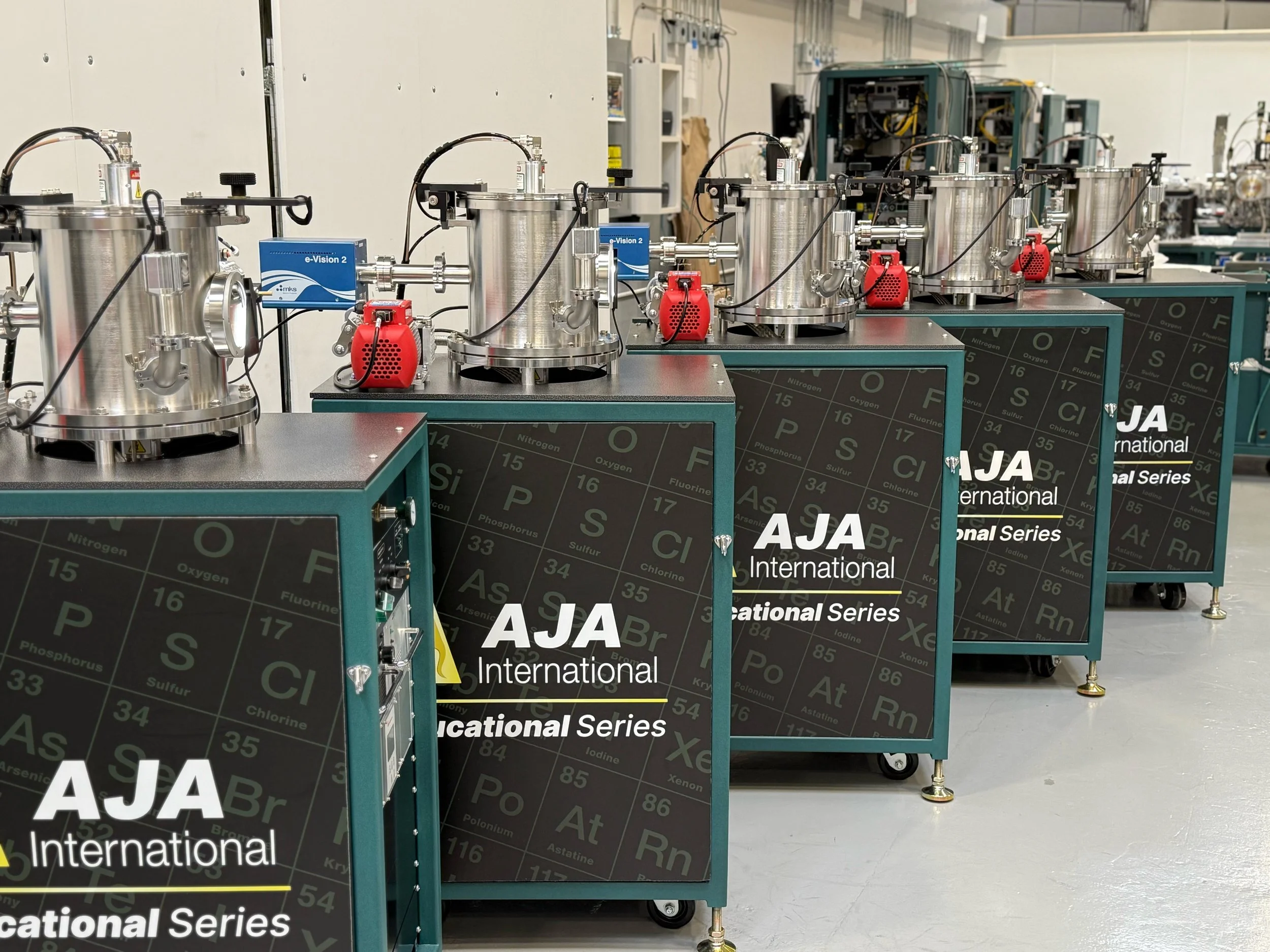
Educational Series
Educational Deposition Systems

Overview
Preparing students to enter technology careers is recognized as one key for our ongoing economic health. The passing of the CHIPS and Science Act justifies strong support of technical training based on such promise. Vacuum technology and thin film coating applications present an excellent opportunity for future technology specialists. This is in no small part due to device properties achievable through thin film coating. This is a critical technology for success in industries ranging from semiconductors to nanotechnology to MEMS to optics and beyond. The value of these is clearly evident in the continued strong growth of the thin film deposition markets worldwide.
The AJA Educational Series system has been designed in collaboration with educators. It is accessible, technically and financially, with simplicity and low cost of operation while focusing on its role as a learning tool. Its manual modes of operation provide a hands-on experience in managing vacuum and vacuum-based processes.
Key Features
Magnetron Sputtering and RF Bias Etch:
The system features an RF powered, 2” magnetron (ST20) facing a water-cooled stage. RF power allows the widest range of materials – both conducting and insulating – to be used as sputtering targets. This target size is the most common and provides many low-cost options. This gives students access to the widest range of materials to explore by a simple target exchange. Samples up to 2” in diameter can be mounted by a clamp ring, while smaller samples are conveniently secured by mounting clips.
The same stage and power supply can also be utilized as a platform for exploring plasma-based etching. The concepts of plasma formation and dynamics such as self-bias can be demonstrated. The resulting sample ion bombardment which leads to beneficial surface effects can readily be demonstrated and investigated. Applications such as surface sputtering for material removal and surface activation can be observed and studied.
Multiple windows and internal lighting provide clear views of components and plasma during operation.
RF Power Supply:
A 100 W RF power supply with auto-tuning network provides power for both the sputter gun and RF stage bias. The concepts of RF power delivery and impedance matching as well as the effects of input power can be shown. Manual adjustment of these parameters provides the opportunity to explore the impact of the power delivery configuration.
Residual Gas Analyzer (RGA):
Insight into the vacuum environment is key to controlling many processes. An optional RGA allows students to gain insight into the composition of the vacuum gas after pump-down. The evolution over time of important residual components such as water vapor, the detection of leaks via oxygen or probe gases such as helium, and the outgassing of detrimental species such as hydrocarbons from in-vacuum materials can be taught and quantified. The RGA allows visualization of these important aspects of vacuum science and technology.
Vacuum System:
A 9.75” ID chamber, 11” high, allows for the introduction of a wide variety of samples through a simple hinge-mounted top lid which provides access to the entire vacuum volume. Pumping can be done either in auto-mode or manually via a combined diaphragm and turbomolecular pump combination. Manual mode allows the step-by-step introduction of pumping technologies, so that students can understand the ranges and limitations of various pumping and valving configurations. A manual butterfly valve provides variable throttling at the pump orifice, which can be operated in conjunction with the process gas valve to control the process pressure. A prominently mounted digital pressure gauge provides real-time feedback and monitoring of pressure changes due to user actions.
The configuration also permits vacuum science phenomena to be taught and demonstrated, in addition to thin film studies. Pump-down curves can be generated to teach the impact of component configuration on pumping speed. Students can get hands-on experience in maintaining a vacuum system.
Facilities:
The Educational Series system is designed for easy set-up and installation in any facility. The system has an air-cooled heat exchanger with closed-loop water cooling, avoiding the need for coolant line input. The system is powered through a standard 110 V power cord (15 A). The only gas facility required is a process gas bottle (typically argon) and regulator. Otherwise, the system is monolithic and mounted on wheels with casters (approximate footprint 30” W × 36” D × 60” H) to allow it to easily be located and run in any classroom or lab location. Safety interlocks for power, vacuum and cooling water status protect the system and users.

The Educational Series in Use
Cornell University’s NanoScale Science and Technology Facility (CNF) in tandem with Tompkins Cortland Community College in New York State, are placing several AJA Educational Series tools in place at their institutions. These will be used for curriculum development and teaching, aiding instruction of students from across the learning spectrum (high school, college, university and adult learning) in vacuum technology, thin film deposition and plasma etching.
Such training is often not available at the undergraduate level. By providing this exposure for students early in their education, they can be qualified for valuable technology careers. This instruction will also benefit those being re-trained to update their skills for a changing industry landscape.

The AJA Educational Series delivers a comprehensive platform for hands-on learning in vacuum science and thin film deposition. Designed with educators, it provides an accessible, cost-effective solution for introducing students to the fundamentals of magnetron sputtering, plasma processing, and vacuum technology. Built around a robust, user-friendly design, the system supports RF-powered deposition and etching on substrates up to 2" in diameter, making it ideal for training in a wide range of materials. With optional analytical tools like a Residual Gas Analyzer (RGA), clear chamber visibility, and manual operation modes, it offers a deep understanding of vacuum processes and film formation. The Educational Series is a powerful tool for preparing students and technicians for careers in semiconductors, optics, MEMS, nanotechnology, and more.
To learn how AJA can support your research, contact our sales team today.




